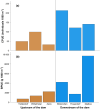Effects of mining activities on fish communities and food web dynamics in a lowland river
- PMID: 38476699
- PMCID: PMC10928357
- DOI: 10.1002/ece3.11111
Effects of mining activities on fish communities and food web dynamics in a lowland river
Abstract
Fish communities of streams and rivers might be substantially subsidized by terrestrial insects that fall into the water. Although such animal-mediated fluxes are increasingly recognized, little is known about how anthropogenic perturbations may influence the strength of such exchanges. Intense land use, such as lignite mining, may impact a river ecosystem due to the flocculation of iron (III) oxides, thus altering food web dynamics. We compared sections of the Spree River in North-East Germany that were greatly influenced by iron oxides with sections located downstream of a dam where passive remediation technologies are applied. Compared to locations downstream of the dam, the abundance of benthic macroinvertebrates at locations of high iron concentrations upstream of the dam was significantly reduced. Similarly, catch per unit effort of all fish was significantly higher in locations downstream of the dam compared to locations upstream of the dam, and the condition of juvenile and adult piscivorous pike Esox lucius was significantly lower in sections of high iron concentrations. Using an estimate of short-term (i.e., metabarcoding of the gut content) as well as longer-term (i.e., hydrogen stable isotopes) resource use, we could demonstrate that the three most abundant fish species, perch Perca fluviatilis, roach Rutilus rutilus, and bleak Alburnus alburnus, received higher contributions of terrestrial insects to their diet at locations of high iron concentration. In summary, lotic food webs upstream and downstream of the dam greatly differed in the overall structure with respect to the energy available for the highest tropic levels and the contribution of terrestrial insects to the diet of omnivorous fish. Therefore, human-induced environmental perturbations, such as river damming and mining activities, represent strong pressures that can alter the flow of energy between aquatic and terrestrial systems, indicating a broad impact on the landscape level.
Keywords: acid mining drainage; aquatic‐terrestrial coupling; benthic invertebrates; browning; metabarcoding; δ2H.
© 2024 The Authors. Ecology and Evolution published by John Wiley & Sons Ltd.
Conflict of interest statement
The authors declare that they do not have any conflict of interest.
Figures




Similar articles
-
Influence of the dietary contribution of terrestrial insects to the condition factor of bleak Alburnus alburnus in a highly polluted lowland river.J Fish Biol. 2024 Nov;105(5):1445-1454. doi: 10.1111/jfb.15835. Epub 2024 Jun 5. J Fish Biol. 2024. PMID: 38840428
-
Summer co-existence of small-sized cyprinid and percid individuals in natural and impounded stretches of a lowland river: food niche partitioning among fishes.J Fish Biol. 2017 Apr;90(4):1609-1630. doi: 10.1111/jfb.13256. Epub 2017 Jan 18. J Fish Biol. 2017. PMID: 28101957
-
Increased Mercury and Reduced Insect Diversity in Linked Stream-Riparian Food Webs Downstream of a Historical Mercury Mine.Environ Toxicol Chem. 2022 Jul;41(7):1696-1710. doi: 10.1002/etc.5342. Epub 2022 May 27. Environ Toxicol Chem. 2022. PMID: 35404497
-
How do small dams alter river food webs? A food quality perspective along the aquatic food web continuum.J Environ Manage. 2024 Mar;355:120501. doi: 10.1016/j.jenvman.2024.120501. Epub 2024 Mar 3. J Environ Manage. 2024. PMID: 38437746
-
Assessment of the impact of dams on aquatic food webs using stable isotopes: Current progress and future challenges.Sci Total Environ. 2023 Dec 15;904:167097. doi: 10.1016/j.scitotenv.2023.167097. Epub 2023 Sep 15. Sci Total Environ. 2023. PMID: 37716688 Review.
Cited by
-
Influence of Lakeshore Riparian Vegetation on Diet, Feeding Rate, and Body Condition of Adfluvial Coastal Cutthroat Trout.Ecol Evol. 2025 Jun 2;15(6):e71470. doi: 10.1002/ece3.71470. eCollection 2025 Jun. Ecol Evol. 2025. PMID: 40458813 Free PMC article.
References
-
- Amisah, S. , & Cowx, I. G. (2000). Impacts of abandoned mine and industrial discharges on fish abundance and macroinvertebrate diversity of the upper River Don in South Yorkshire, UK. Journal of Freshwater Ecology, 15, 237–250.
-
- Amundsen, P. A. , & Sánchez‐Hernández, J. (2019). Feeding studies take guts – critical review and recommendations of methods for stomach contents analysis in fish. Journal of Fish Biology, 95, 1364–1373. - PubMed
-
- Andersson, P. , & Nyberg, P. (1984). Experiments with brown trout (Salmo trutta L.) during spring in mountain streams at low pH and elevated levels of iron, manganese and aluminium. Report‐Institute of Freshwater Research, Drottningholm, 61, 34–47.
-
- Bartels, P. , Cucherousset, J. , Steger, K. , Eklöv, P. , Tranvik, L. J. , & Hillebrand, H. (2012). Reciprocal subsidies between freshwater and terrestrial ecosystems structure consumer resource dynamics. Ecology, 93, 1173–1182. - PubMed
-
- Baxter, C. V. , Fausch, K. D. , & Saunders, W. C. (2005). Tangled webs: Reciprocal flows of invertebrate prey link streams and riparian zones. Freshwater Biology, 50, 201–220.
LinkOut - more resources
Full Text Sources

